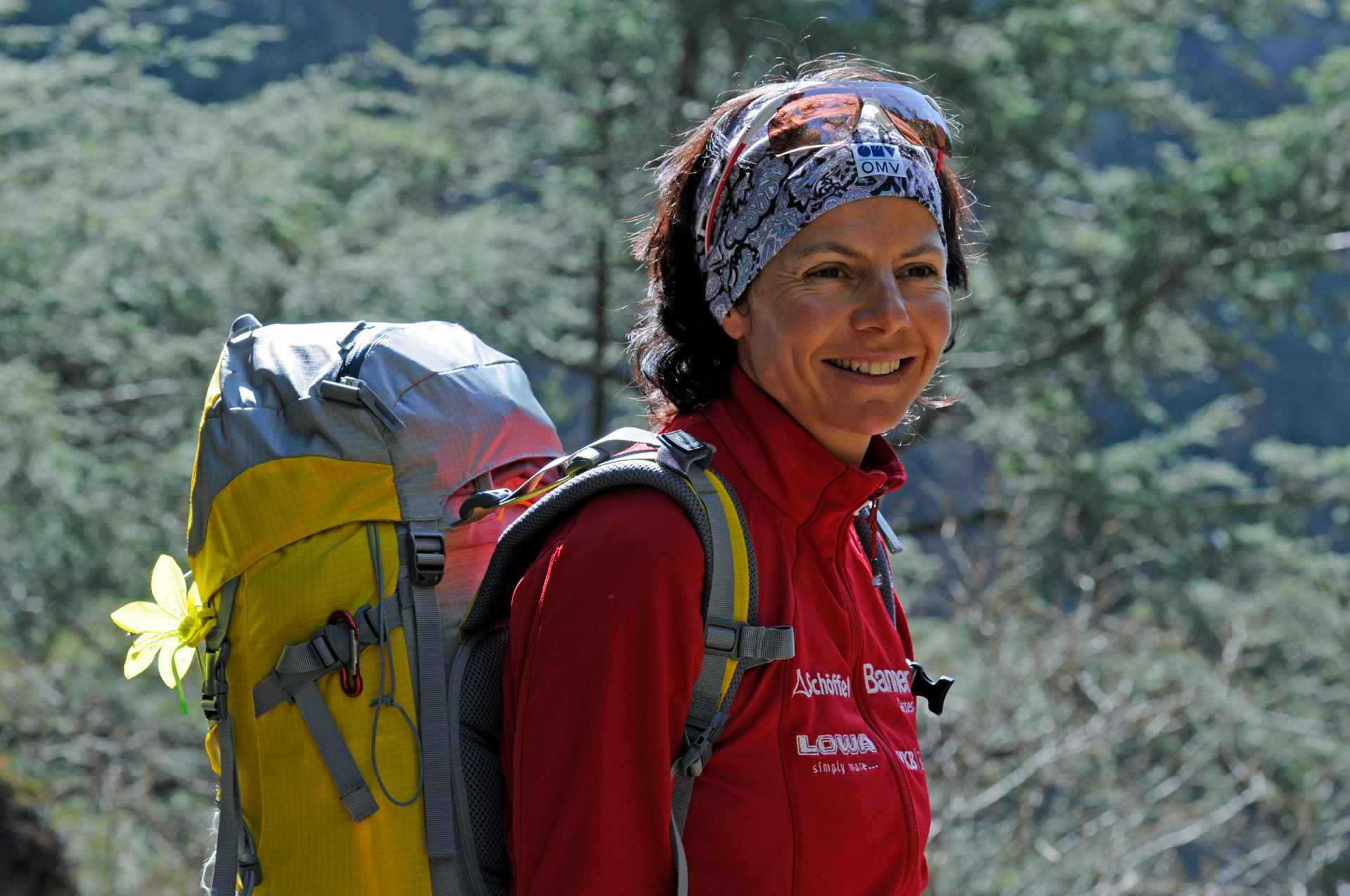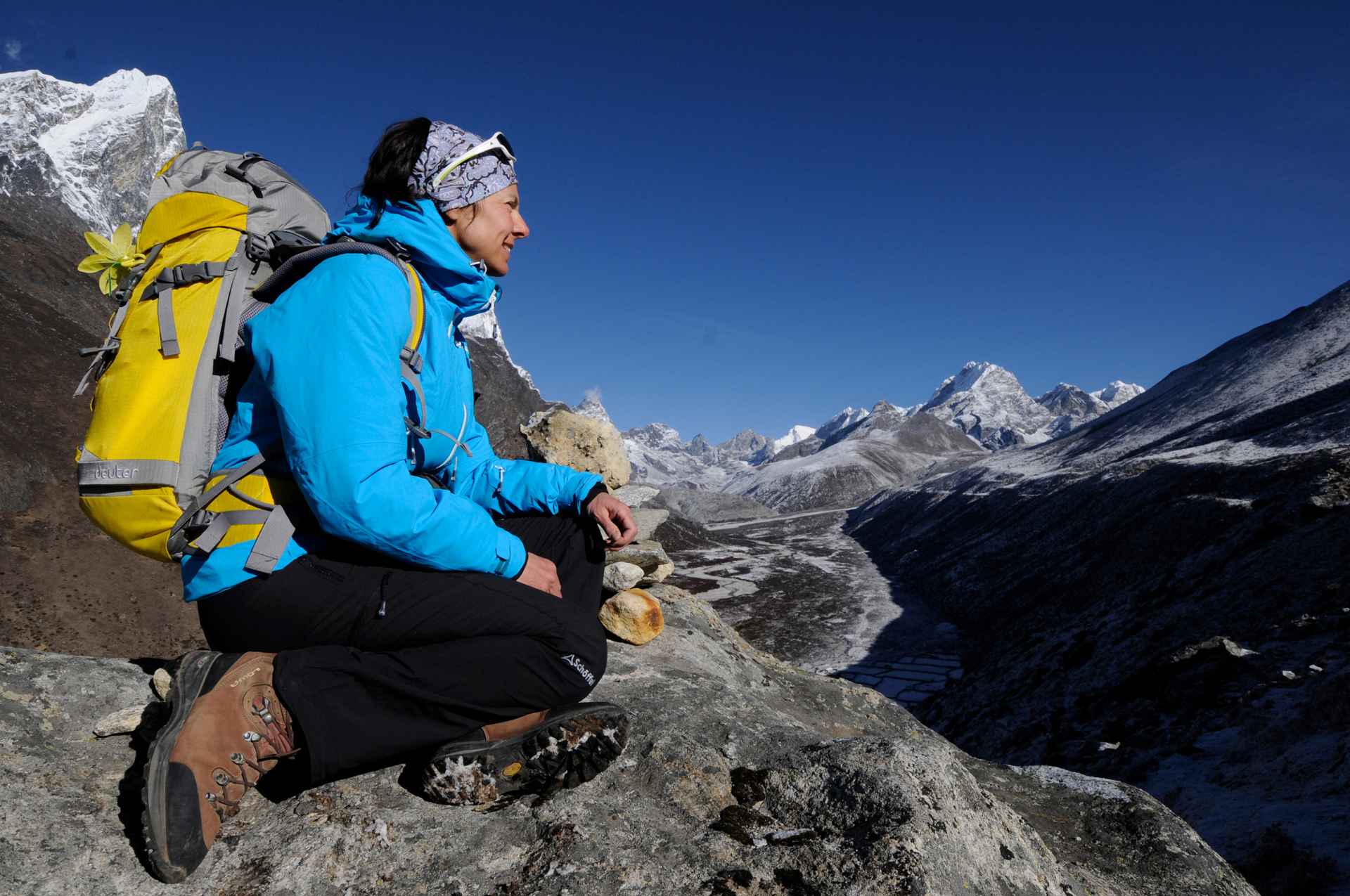LOWA PRO Team Gerlinde Kaltenbrunner
With LOWA on 14 eight-thousanders
Gerlinde Kaltenbrunner’s interest in mountain climbing was born while she was very young and grew from there. Her stunning entry into the world of mountaineering was initiated by the head of a church youth group in her Upper Austrian hometown of Spital am Pyhrn – the local parson, Dr Erich Tischler. After mass on Sundays, he took Gerlinde Kaltenbrunner on all sorts of climbing tours – starting with the mountains that surround her hometown. As the years passed, she didn’t miss an opportunity to go mountain climbing.
She fulfilled her biggest dream – conquering an eight-thousander – at the age of 23 by ascending the Broad Peak lower-secondary summit in Pakistan at an elevation of 8,027 metres. Ever since then, she’s had nothing but visions of heights and the highest mountains floating through her head. After conquering the Nanga Parbat in 2003 as her fifth eight-thousander, she devoted her life to professional mountaineering. When she reached the summit of K2 in 2011, Gerlinde stood at the pinnacle of her career: She had climbed all 14 eight-thousanders. She is the first woman to climb all 14 eight-thousanders without the help of additional oxygen.
Her passion for the world’s highest mountains was honoured in 2016 at the sports trade fair ISPO Munich. Gerlinde was presented with the ISPO Trophy as “Sports Personality of the Year”. Gerlinde’s social work was recognised along with her athletic achievements. For many years now, the extreme mountain climber has worked on behalf of the Nepalhilfe Beilngries, an organisation that builds village schools, day-care centres and clinics.

Facts & figures
- Birthday:
- 13.12.1970
- Birthplace:
- Kirchdorf
- Home base:
- Attersee
- Profession:
- trained nurse
- Favourite climbing site:
- Gesäuse/Styria
- Local mountain:
- Schafberg and Mahdlgupf
- Height:
- 1,73 m
- Weight:
- 55 kg
Gerlinde Kaltenbrunner,
When did you start working with LOWA?
“I have been a professional partner of LOWA since 2004. Even before our official partnership I already mostly wore LOWA footwear. Thus, I could almost immediately identify with the brand and since then always wear LOWA when I’m out and about.”
What in your view makes for a good partnership?
“A good partnership for me means that, as athletes we can offer our ideas for the products. Precisely with models that we use ourselves. Furthermore, I’m thrilled that Werner Riethmann allows development and production to continue with speciality footwear for us, although they are not produced in great numbers. In addition to the expedition boots, one example is the ice climbing shoe by Ines Papert. From the beginning, we have been included in the process and asked: What could we do better? What do you need? Over many years of collaboration, the partnership has become more and more constructive. The athlete team has developed. We often exchange ideas among ourselves and are out on adventures together quite a bit.”
What are your plans for the coming period?
“I have not been out on expeditions in the last two years. That was essential for me and quite good, but now I feel the longing to head out again. Next summer, I would like to take on a nice six-thousanders or seven-thousanders expedition. In the back of my mind I still have Gasherbrum IV, an interesting seven-thousanders in Pakistan. I would love to go to India for some mountaineering, because there one can find very many technically demanding six-thousanders. Eight-thousanders are for me however definitely done. There are so many really nice six-thousanders and seven-thousanders that are still to be explored. In addition, I’m often out ice climbing these days, which I am greatly enjoying. That really came up short in the last few years with all of the expeditions. I would also like to continue to give lectures. To inspire others to their own goals is something I find very fulfilling and makes me happy.”
What do you think of high-altitude tourism?
“There is a certain ambivalence that I even have when I’m out on high mountains. Only because I’m now done with that chapter I won’t however say that it is not a good development. Still, in recent years, unfortunately, more and more people who do not have any mountaineering experience are out on the high mountains. On Mt. Everest, I have personally seen participants who even had problems getting on their crampons. There is simply a lack of the necessary background knowledge to take on such a huge goal. I wish that individuals would develop a consciousness to first take on smaller goals that can be achieved under their own power and thus gain experience for higher mountains.”
How does your vegan lifestyle affect your performance?
“With vegan nutrition, I feel good. In Nepal or Pakistan it is very easy to eat vegan. There, one can find many plant-based meals. For example, there are 35 different kinds of lentils, which have a high percentage of protein. In addition, there are a lot of rice, vegetable and potato dishes. In these countries I am always well fed, and I always bring nuts, dried fruit and seeds from home. Ever since I have followed a plant-based diet, I sleep better, my concentration has improved, and my recovery after training has shortened. For me, personally, this style of eating has a lot of advantages.”
My shoes for…
Approaches: ALPINE SL GTX
“If offers very good grip in moderately rocky terrain and its low weight and super fit make the ALPINE SL GTX my absolutely favourite footwear!”



